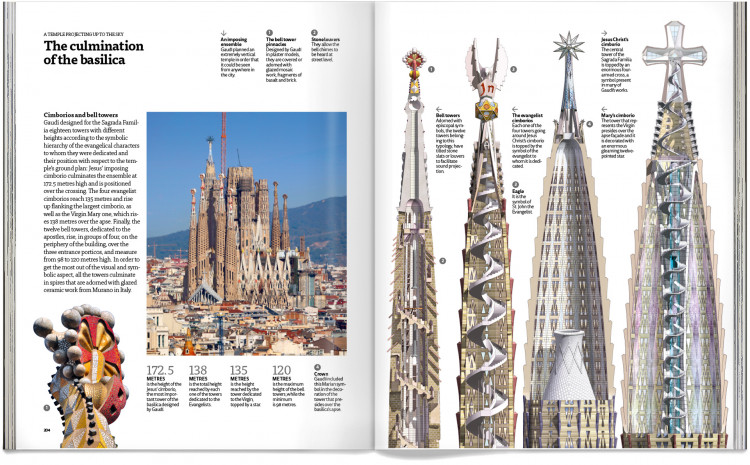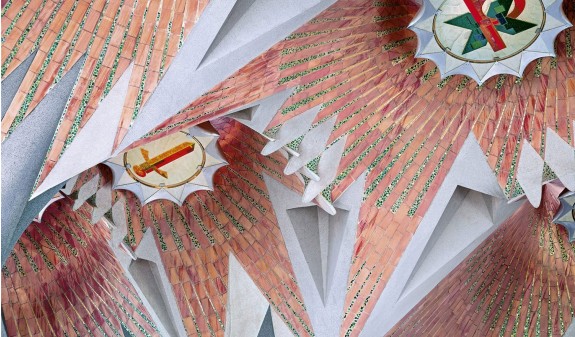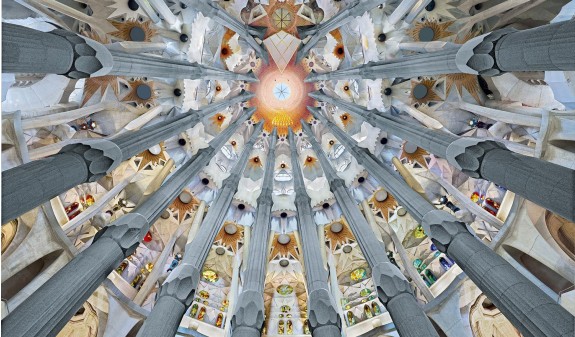The Basilica of the Sagrada Familia
The most important work of architect Antoni Gaudí
About the book The temple of the Sagrada Familia
Obsessed with the idea of creating the perfect temple, Gaudí dedicated the last 43 years of his life to the construction of the Sagrada Familia, in such a way that the monument constitutes a compendium of all the technical solutions developed by the architect over his long professional career. Likewise, the temple reflects the indepth liturgical knowledge of Gaudí, who through a detailed iconographic programme, set about transforming Sagrada Familia into a great Bible made of stone.
This book on Sagrada Familia, published by Dosde, analyses the innovative structure and the deep allegorical significance of the temple, as well as its origins and evolution. Declared a World Heritage Site by Unesco in 2005, the Basilica of the Sagrada Familia has converted into the most emblematic building of Barcelona, the city in which Gaudí developed most of his work.
Deluxe Edition
The Basilica of the Sagrada Familia
It includes exclusive digital content
Made with environmentally friendly paper
Official licensed product
"Premio Clap Platinum" Best Illustration
About the book The temple of the Sagrada Familia
Obsessed with the idea of creating the perfect temple, Gaudí dedicated the last 43 years of his life to the construction of the Sagrada Familia, in such a way that the monument constitutes a compendium of all the technical solutions developed by the architect over his long professional career. Likewise, the temple reflects the indepth liturgical knowledge of Gaudí, who through a detailed iconographic programme, set about transforming Sagrada Familia into a great Bible made of stone.
This book on Sagrada Familia, published by Dosde, analyses the innovative structure and the deep allegorical significance of the temple, as well as its origins and evolution. Declared a World Heritage Site by Unesco in 2005, the Basilica of the Sagrada Familia has converted into the most emblematic building of Barcelona, the city in which Gaudí developed most of his work.
Videos The Basilica of the Sagrada Familia
Readers opinions
(18)
Reviews
(18)
Readers opinions
(18)
Additional Information
- Additional Information
- Subtitle: The most important work of architect Antoni Gaudí
- Weight (g): 1450
- Binding: Hard cover
- Size (cm): No
- Author: Dosde
- Pages: 192
- Edition: Deluxe Edition
The origins of Sagrada Familia
The nineteenth century was a complicated period for Christianity in Europe, and Barcelona was a paradigm of these difficulties. The Church, which had wielded great influence throughout the entire history of Spain, saw its authority greatly challenged due to the action of the successive liberal governments that held power in the decades following the French Revolution and the War of Independence.
The foundation in 1866 of the Association of Devotees of Saint Joseph was part of this reaction by the Church to recover its spiritual influence on society. The fact that by 1878 the association already had half a million members encouraged its creator, bookseller and philanthropist Josep Maria Bocabella, to take up the construction of an expiatory temple dedicated to the Holy Family, subsidised by worshippers’ donations on a plot of land in the Eixample. After several years of preparation, building work started on the 19th of March, 1882.
Francisco del Villar was Sagrada Familia’s first architect who devised a neo-Gothic temple, in accordance with the historicist trends prevailing at the time. However, just one year after the start of the building work, Del Villar resigned from managing the project due to differences with Bocabella and his main consultant, historicist architect Joan Martorell.
After Del Villar’s resignation, Bocabella offered the supervision of the building work to Joan Martorell, his consultant, but the latter declined and recommended his most talented disciple: a 31 year old architect namedAntoni Gaudí.
La Sagrada Familia, Gaudí's masterpiece
Gaudí took charge of the building work in 1883 and combined the temple’s construction with his other projects, until 1914 when he decided not to take on any more commissions and to dedicate himself exclusively –up to his death in the year 1926– to the Basilica of the Sagrada Familia.
Gaudí set out to erect a building of enormous dimensions on a Latin cross ground plan with five naves. Using the great medieval cathedrals as one of his sources of inspiration, Gaudí proposed the reinterpretation of the Gothic style as a necessary concept for the Sagrada Familia in order to establish a close relationship between heaven and earth by means of height and light.
The architect was inspired by nature at the time of devising the complete project for the basilica, inspired by trees to create the interior's columns and incorporating animal scultures and elements from the natural world on the façades and towers. The 43 years that Gaudí dedicated to the construction of the Sagrada Familia enabled the architect to understand that his project was able to achieve what for centuries no other architect before him had managed to do: to construct a perfect temple.































